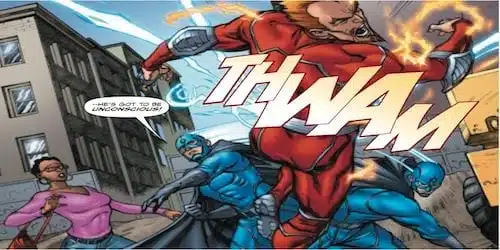
Comicbooks, although only capturing a fraction of their original mass market audience, have one irreproachable strength over other forms of storytelling. Timelessness. The characters in comics are eternal. Certain core tenets must be upheld when writing these characters.
For all the innovations and storytelling eccentricities on display in modern comics, the medium is essentially a static field. Simply look at the seventy plus years of publishing history behind Superman and Batman, the two most iconic superhero comic book characters in existence. While the characters may be more refined and complex today than they were in the 1930s, they are undoubtedly the same characters.
Superman may have been a social crusader with a bit of a mean streak when he first appeared, but his cape, tights and boots, along with his commitment to protect the innocent, have endured until today. Batman initially dispatched criminal with extreme prejudice but still remains (arguably clarified through Grant Morrison’s recent changes) a creature of the night.
Neither of these characters has grown up and, conceivably, neither character will ever receive an ultimate end. Batman’s vast publishing catalogue will never end with him settling down and marrying to the quiet suburbs. Comics are too static, timeless and archetypal for this to be played out.
Stan Lee’s The Traveler, the second launch in the writer’s efforts to create an all-new comic universe, showcases the timeless aspect of comics in a very direct way by granting the protagonist time altering powers. The Traveler confronts the dastardly Split Second Men, a trio of time travelers with ostensibly nefarious schemes that involve, in a very Terminator-esque way, plots to kill otherwise average women who may have a date with destiny down the road.
Although little is revealed about the Traveler and his adversaries, it is made clear by writer Mark Waid and artist Chad Hardin, that there is a greater cosmology in play than the reader is privy to.
However, the caveat to the Traveler’s powers is that although he faces off against time travelers, he himself is unable to move throughout time. When asked by a woman he saves if he can time travel, the hero simply states, “No. I can play some wonderful tricks with it, however.” These include speeding up and slowing down time, examples include accelerating time to make a quick escape or slowing down time to cushion his fall, but the Traveler cannot suddenly jump forward fifty years like his enemies can.
This demonstrates the inherent timelessness of comic book heroes. Villains are typically not constrained as heroes are. There are plenty of instances of comic book villains evolving and growing well beyond their original roots.
However, comic book heroes are relatively static. Comic book writers give the impression of movement, akin to the Traveler’s ability to speed up or slow down time, but are essentially locked in place. Captain America will always be the man out of time. Superman will always fight for truth and justice. Writers can toy with these concepts but there are irrefutably central to the composition of the character.
Mark Waid is an expert at highlighting this in his seminal collaboration with Alex Ross on Kingdom Come. While that story is set in the future of the DC Universe and has an eclectic cast that have gone through numerous physical changes, the character themselves remain largely the same. The Flash still lives between the ticks of a second. Batman still strives to prevent the wrong done to him from being committed against others.
This attribute is one of comic’s greatest strengths. What other form of media can purport a seventy year old uninterrupted publishing schedule focused on a beloved character? Television can’t match that. Hollywood, despite its fixation with sequels, can never attain that status. Even other print sources have a hard time matching the publishing prowess of Spider-Man, Superman and Batman. The Traveler is living proof that comic book superheroes exist eternally in the imagination of fans and writers.
Nevertheless, as the Traveler indicates “Freezing time is not as easy as it looks.” This timelessness has also been identified as one of the core drawbacks, by such figures as writer Alan Moore, to superheroes, making this attribution a double edge sword. While these characters may be eternal, they are also endless. The beginning of a character is as equally important as its end. Many comic book characters will never know an end.
Regardless, Stan Lee’s The Traveler is an insightful look at how comic book superheroes exist within a vacuum of time. Their stories may grow more complex but they are essentially the same. Their doubled edged iconography not only ensures they have a persistence in popular culture but also denies them a fitting conclusion to their saga. For better or worse, comic book characters can never die.
